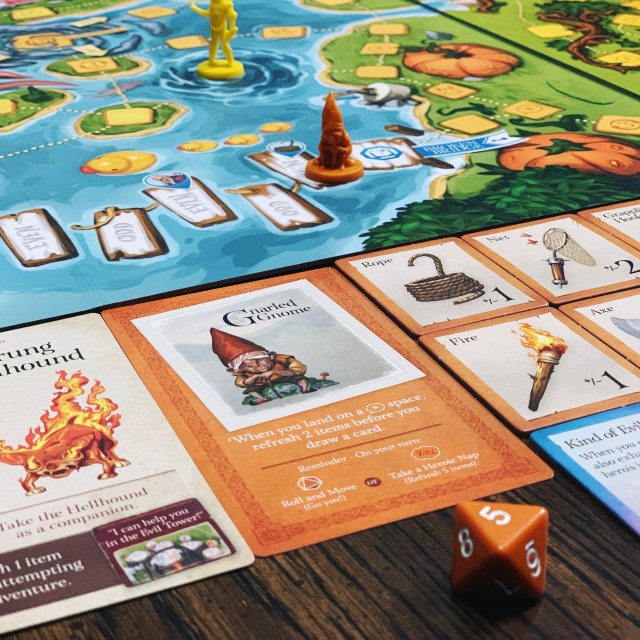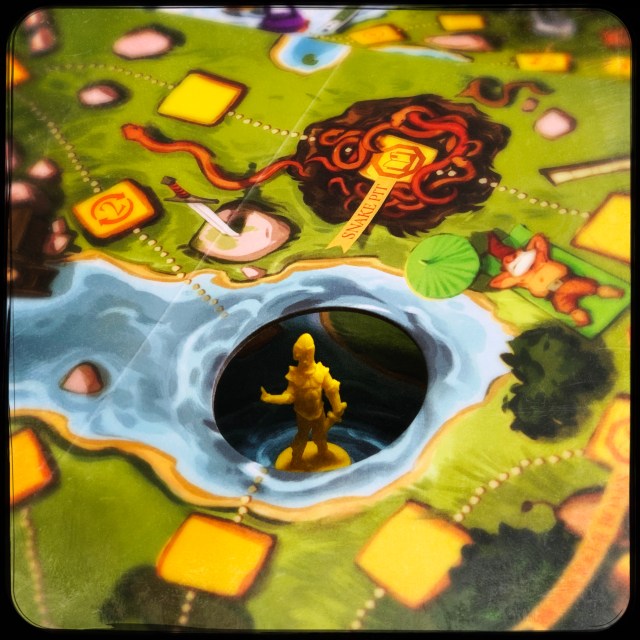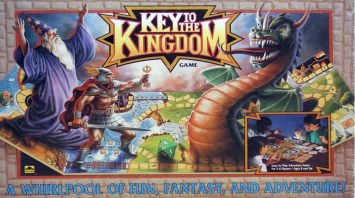
By the time the original Key to the Kingdom came out in 1990, I had already spent 3 years as a DM (that’s Dungeon Master for those who’ve never played and/or watched Stranger Things), played pretty every stand-alone board game made by Games Workshop or TSR (hot take: TSR’s Dungeon is an unbelievably crappy game), dabbled in bit in games like Melee/Wizard (which later became The Fantasy Trip) and Magic Realm (hot take: still too much fiddle to be enjoyable), and – oh yeah – I was busy getting married that summer. There was literally no chance that a game with a cover that featured excited children…
…was going to jump to the top of my wishlist. (My big purchase from that time period was the original edition of Space Hulk.) So, I vaguely remember seeing it at the time… and then I’ve seen copies in thrift stores over the years… but I’ve never played the original version designed by Paul Bennett.
Fast forward 32 years (yes, my wife & I are about to celebrate our thirty-second anniversary!) and the release of Restoration Games’ new edition of Key to the Kingdom, lovingly restored by Matthew O’Malley and Ben Rossett.
Since I can’t compare the two (except to say I like the new cover better), what follows is actually a review of what’s in the box now – and the fun we’ve had with it.
The Story (Such As It Is)
You see, there’s a demon king – and someone has got to defeat him and claim his throne and his mountain of treasure and his Twitter followers and all that… and then move to Florida and retire. Your mission – if you choose to accept it – is to be that hero.
In order to do that, you’ll take the resources you have plus a singular special power and dive into the kingdom seeking adventures, companions, and three pieces of the titular key. Once you have those, you can jump into one of the magical whirlpools and teleport to the evil tower to face the demon king’s minions and, if you’re successful, the demon king.
Look, Hollywood is littered with weaker fantasy trope plots (I’m looking at you, Legend & Krull – what the heck were y’all thinking?). So have board games – we just played Prophecy this last weekend (with both the Dragon Realm and the Water Realm) and it pretty much covers the same territory. As does the Games Workshop “classics” Talisman or The Warlock of Firetop Mountain… or the weird but wonderful Euro-ish Return of the Heroes.
So what sets Key to the Kingdom apart from the rest of the pack?
- It doesn’t take itself too seriously. (Any game that includes a card modeled after Rick Astley certainly isn’t trying for the Weighty High Fantasy Quest trophy.)
- It doesn’t make the game last longer than the director’s cut of The Return of the King. (With 2-3 players, we finished in about 30 minutes. We ran just over an hour with five players.)
- It doesn’t subject you to the whims of mercurial dice and random card flips. (Well, it does – but the game is designed with tools to mitigate those things.)
My 17 year old son summed it up nicely: “It’s like a shorter Talisman with actual strategy.”
Gameplay
Each player starts the game with a character card, a matching figure, 8 item tiles, and a lovely matching die. You can be the Gnarled Gnome, the Knovice Knight, the Merciless Mercenary, the Pitiless Pixie, or the Unique Unicorn. As you can see, the designers spared no expense in making sure alliteration was strewn throughout the kingdom. (It’s possible they bought their own thesaurus whilst disabling spell check on their computers.)
You can take one of two kinds of turns:
- Adventure Fun Time! (no, that’s not the official name)
- Roll your 8-sided die
- Modify it with one of your items (optional)… flipping that item to “exhausted” side
- Use your entire roll and move, skipping any space occupied by another player
- Interact with the space you land on
- Heroic Nap (yes, that’s what it’s called in the rules)
- Refresh five of your resources
- Enjoy a well-deserved break from all of that exhausting die rolling
Interaction with spaces is pretty straightforward:
- Adventure spaces – follow the simple rules in the Adventure Guide (a supplement to the rulebook) in order complete some kind of dice game for a reward – it could be a companion, an easier way to move through a part of the map, the chance to abscond with an item from another player… or even a part of the all-important Key.
- Note: Key adventures require multiple steps – and reward players with a particular unused item and/or a certain companion the chance to skip some of those steps. Failing a Key adventure boots you back out to the main board in some manner, but there isn’t any other penalty.
- Event spaces – draw an Event card and resolve it.
- Refresh spaces – refresh some number of exhausted items
- Demon die spaces – hand someone else the Demon Die… it could be you, it could be another player – it just can’t be the person who currently has it
- The Demon Die has a much wider variety of results – including two zeroes and an eleven.
- Boring spaces – nothing happens
- Whirlpool spaces – well, that brings us to…
The Board

I would be remiss if I did not mention the folding board innovation… which I was aware of courtesy of (a) the original game, and (b) the over-the-top use of a similar trick in the very drug-trippy game The Mushroom Easters. (Note: our own Frank “Moo” Branham introduced me to The Mushroom Eaters, which not only has folding boards but also 3D glasses to view the very “70s teenager with black light posters” board art.)
But we’re not here to talk about The Mushroom Eaters… instead, when one of our intrepid Key to the Kingdom heroes leaps into a whirlpool, a portion of the board either opens (if it’s closed) or closes (if it’s open), revealing or hiding portions of the kingdom. Anyone else on the moving portion of board is relegated to the Void spot (the hole) when it opens or the whirlpool when it closes.
It’s a cute gimmick that works nicely with a minimum of fuss – with the possible exception of needing a decent amount of table space of the whole board is open at the same time.
The Big Finish
Eventually, one or more players will acquire the three different key parts and head for the nearest whirlpool in order to jump to the side board, The Demon King’s Domain, wherein you’ll need to battle (roll dice) to defeat a three-eyed octopus, a passel of raccoons, and – in a move that seems straight of Evil Henchmen Casting, a bevy of clowns before facing off against the Demon King himself. Against the Demon King, the “modify your roll using one item only” rule is out the window – you can throw everything you have into defeating the bad guy!
Cleverly, failure here simply sends you back to a holding area on the side board at the foot of the Demon’s castle, giving you the opportunity to refresh your items to be ready for your next attempt. (I say this as someone who has played a lot of these kind of quest games: Key to the Kingdom is not structured to make the ‘big bad’ encounters stretch on interminably. And I’m grateful for that.)
Final Thoughts
There are a number of thoughtful touches to the design and production of Key to the Kingdom (which isn’t really a surprise coming from Restoration Games.
- The box is exactly the right size to hold the components – and the insert sorts everything nicely and protects the tabs that connect the two-piece main board.
- Each player has their own individual 8-sided die in their player piece color… which means game play can move at a quicker pace (no figuring out who has the die). This also allows the game to have multiple adventures that involve all players rolling their dice… this was a particularly nice feature in our five player game, as it keeps everyone paying attention.
- The humor is really well-pitched… it’s very dad-jokey and heavy on the alliteration and the puns – but not in a way that is irritating or off-putting. (If you’ve played the Restoration Games version of Fireball Island, you’ll understand the nice balance they can achieve with a humorous tone.)
- The artwork is adorable without being too cutesy – meaning it isn’t off-putting to family members as a “boy game” or a “girl game”.
I think it’s a great closer for a group of gamers, a lovely family game for kids who want to play a fantasy game but aren’t old enough to dig into some of the epic quest games out there… and I’m glad it has a place on my gaming shelf. I’m looking forward to introducing it to my great-nieces and nephews as they get older – and I’ll be happy to play it with whoever asks.
My recommendation? This would be a really good game to get a family with elementary school age children to play together… and you won’t be seeking for excuses to duck out when they ask you to join them.
Note: I received a review copy of Key to the Kingdom from Restoration Games.



